罗氏电化学发光免疫分析
罗氏电化学发光免疫分析仪测试项目定标物保存方法
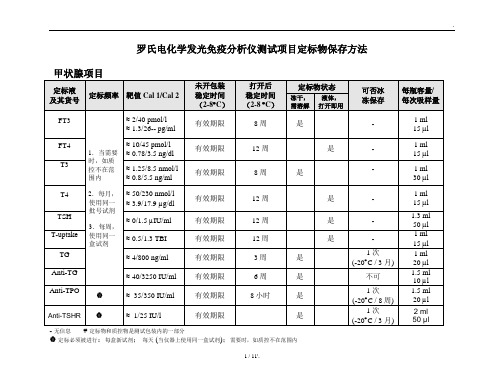
罗氏电化学发光免疫分析仪测试项目定标物保存方法无信息定标物和质控物是测试包装内的一部分定标必须被进行:每盒新试剂;每天 (当仪器上使用同一盒试剂);需要时,如质控不在范围内心肌标志物性激素项目肿瘤标志物贫血诊断指标、骨标志物传染病项目其它唐氏筛查先兆子痫罗氏电化学发光免疫分析仪定标物保存方法(简版)定标物不需要分装冰冻保存的项目:使用时从2-8︒C取出,摇均后吸200μl(此数据为国内实验室试验所得,不代表罗氏官方)到日立杯,马上将剩余定标品放回2-8︒CFT3、FT4、T3、T4、TSH、T-uptake、Anti-TG、HCG+β、HCG STAT、ProgesteroneCEA、CA 125、CA 153、CA 724、Cyfra21-1、NSE、Free PSA、HE4Myoglobin、Myoglobin - STAT 、Digoxin、Digitoxin、Ferritin、IgE、β-CrossLapsAnti-HAV、Anti-HAV IgM、HBsAg、HBsAg II quant、 Anti-HBs、HBeAg、Anti-HBe、Anti-HBc、 Anti-HBc IgM、 HIV combi、HIV Ag 、HIV combi PTToxo IgG、 Toxo IgM、Rubella IgG、Rubella IgM、CMV IgG、CMV IgM定标物需要分装冰冻保存的项目:定标物加水复溶,用子弹头进行分装(分装量为200μl(此数据为国内实验室试验所得,不代表罗氏官方)),然后放在-20︒C保存,使用时取出并平衡到室温TG、Anti-TPO、 Anti-TSHR、CK-MB、CK-MB STAT、ProBNP、Troponin T HS、Troponin T HS STAT free βHCG、PAPP-A、 Insulin、C-peptide、IL-6 、PCT、Anti-CCP.Cortisol、ACTH、Estradiol II、FSH、LH、Prolactin、Testosterone、DHEA-S、SHBG、PIGF、 sFlt-1、hGHAFP、CA 199、TPSA、S100Vitamin B12、Folate III 、N-MID、Total P1NP、PTH、PTH STAT、PTH(1-84)Vitamin D3、Vitamin D totalHSV-1 IgG、 HSV-2 IgG11 / 11'.。
罗氏cobas 6000 e601全自动电化学发光免疫分析仪性能验证

温一 次 ,检测 1 0 ai r n 。要求 温度 值在 2 0 . 0± 3 ℃ 内,
波动 度不 大于 ± 2 o C。 ( 2 )孵 育 盘温度 准确 性及 波 动 。 将经 过标 定 的精度 为 0 . 1 ℃ 的 温度 检 测 仪 探 头
-
验 证方法 、标 准及结果 等做如下 总结汇报 。
1 材 料和 方法
4 - 0 . 3 c i C内 ,波动 度不 大 于 ± 0 . 2 ℃。 ( 3 )测 量池 温度 准确 性及 波动 。 将 经 过标定 的精 度 为 0 . 1 ℃ 的 温度 检 测仪 探 头
仪 器 设 备 :德 国 罗 氏 c o b a s 6 0 0 0 e 6 0 1全 自动 电化学 发光 免疫 分 析仪 、经过 标定 的 温度计 及加 样 器 各一 支 。
( 1 )试 剂仓 温度 准 确性及 波 动 。
将经 过标 定 的精度 为 0 . 1 o C的 温度 检 测 仪 探 头
放入 试剂 仓 中 ,在 温度 显 示 稳 定 后 ,每 隔 1 mi n测
发光免疫 分析仪是 否满足厂商规 定 的分析性 能要求 ,
我院于 2 0 1 4年 1月 1 2 日与 罗 氏诊 断 产 品 ( 上海 )
全 自动 电化 学发 光 免 疫 分析 仪 进 行 仪器 性 能 验证 。 验证 内容 包括 :试 剂仓 温度 准 确性 及 波 动 、孵 育 盘 温度准确 性及 波动 、测 量池 温度 准 确 性及 波 动 、加
样 系统准 确性 与重 复 性 、交 叉 污染 及 灵敏 度 。现将
Hale Waihona Puke 放人 孵 育 盘 小 孑 L中,在 温 度 显 示 稳 定 后 , 每 隔 1 m i n测 温 一 次 ,检 测 1 0 a r i n 。要 求 温 度 值 在 3 7 . 0
罗氏 cobas e 801 电化学发光免疫分析仪使用说明书 - 检测抗 HBs 抗体的试剂盒
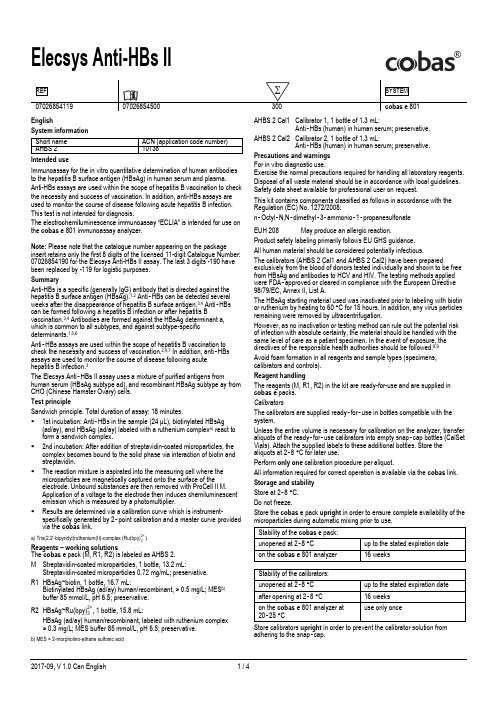
Elecsys Anti-HBs IIREFSYSTEM********************** 300cobas e 801EnglishSystem information Short name ACN (application code number) AHBS 2 10138 Immunoassay for the in vitro quantitative determination of human antibodies to the hepatitis B surface antigen (HBsAg) in human serum and plasma.Anti-HBs assays are used within the scope of hepatitis B vaccination to check the necessity and success of vaccination. In addition, anti-HBs assays are used to monitor the course of disease following acute hepatitis B infection. This test is not intended for diagnosis.The e lectro c hemi l uminescence i mmuno a ssay “ECLIA” is intended for use on the cobas e 801 immunoassay analyzer.Note: Please note that the catalogue number appearing on the package insert retains only the first 8 digits of the licensed 11-digit Catalogue Number: 07026854190 for the Elecsys Anti-HBs II assay. The last 3 digits -190 have been replaced by -119 for logistic purposes. SummaryAnti-HBs is a specific (generally IgG) antibody that is directed against the hepatitis B surface antigen (HBsAg).1,2 Anti ‑HBs can be detected several weeks after the disappearance of hepatitis B surface antigen.3,4 Anti ‑HBs can be formed following a hepatitis B infection or after hepatitis Bvaccination.3,4 Antibodies are formed against the HBsAg determinant a, which is common to all subtypes, and against subtype-specific determinants.1,5,6Anti ‑HBs assays are used within the scope of hepatitis B vaccination to check the necessity and success of vaccination.2,4,7 In addition, anti ‑HBs assays are used to monitor the course of disease following acute hepatitis B infection.3The Elecsys Anti ‑HBs II assay uses a mixture of purified antigens fromhuman serum (HBsAg subtype ad), and recombinant HBsAg subtype ay from CHO (Chinese Hamster Ovary) cells. Test principleSandwich principle. Total duration of assay: 18 minutes.▪ 1st incubation: Anti ‑HBs in the sample (24 μL), biotinylated HBsAg(ad/ay), and HBsAg (ad/ay) labeled with a ruthenium complex a) react to form a sandwich complex.▪ 2nd incubation: After addition of streptavidin-coated microparticles, thecomplex becomes bound to the solid phase via interaction of biotin and streptavidin.▪ The reaction mixture is aspirated into the measuring cell where themicroparticles are magnetically captured onto the surface of the electrode. Unbound substances are then removed with ProCell II M. Application of a voltage to the electrode then induces chemiluminescent emission which is measured by a photomultiplier.▪ Results are determined via a calibration curve which is instrument-specifically generated by 2‑point calibration and a master curve provided via the cobas link.a) Tris(2,2'-bipyridyl)ruthenium(II)-complex (Ru(bpy)32+)Reagents – working solutionsThe cobas e pack (M, R1, R2) is labeled as AHBS 2. M Streptavidin-coated microparticles, 1 bottle, 13.2 mL:Streptavidin-coated microparticles 0.72 mg/mL; preservative. R1 HBsAg~biotin, 1 bottle, 16.7 mL:Biotinylated HBsAg (ad/ay) human/recombinant, > 0.5 mg/L; MES b) buffer 85 mmol/L, pH 6.5; preservative. R2 HBsAg~Ru(bpy)32+, 1 bottle, 15.8 mL:HBsAg (ad/ay) human/recombinant, labeled with ruthenium complex > 0.3 mg/L; MES buffer 85 mmol/L, pH 6.5; preservative.b) MES = 2-morpholino-ethane sulfonic acidAHBS 2 Cal1 Calibrator 1, 1 bottle of 1.3 mL:Anti ‑HBs (human) in human serum; preservative.AHBS 2 Cal2 Calibrator 2, 1 bottle of 1.3 mL:Anti ‑HBs (human) in human serum; preservative.Precautions and warnings For in vitro diagnostic use.Exercise the normal precautions required for handling all laboratory reagents. Disposal of all waste material should be in accordance with local guidelines. Safety data sheet available for professional user on request.This kit contains components classified as follows in accordance with the Regulation (EC) No. 1272/2008:n ‑Octyl ‑N,N ‑dimethyl ‑3‑ammonio ‑1‑propanesulfonateEUH 208 May produce an allergic reaction.Product safety labeling primarily follows EU GHS guidance. All human material should be considered potentially infectious.The calibrators (AHBS 2 Cal1 and AHBS 2 Cal2) have been preparedexclusively from the blood of donors tested individually and shown to be free from HBsAg and antibodies to HCV and HIV. The testing methods applied were FDA ‑approved or cleared in compliance with the European Directive 98/79/EC, Annex II, List A.The HBsAg starting material used was inactivated prior to labeling with biotin or ruthenium by heating to 60 °C for 15 hours. In addition, any virus particles remaining were removed by ultracentrifugation.However, as no inactivation or testing method can rule out the potential risk of infection with absolute certainty, the material should be handled with the same level of care as a patient specimen. In the event of exposure, the directives of the responsible health authorities should be followed.8,9 Avoid foam formation in all reagents and sample types (specimens, calibrators and controls). Reagent handlingThe reagents (M, R1, R2) in the kit are ready-for-use and are supplied in cobas e packs. CalibratorsThe calibrators are supplied ready ‑for ‑use in bottles compatible with the system.Unless the entire volume is necessary for calibration on the analyzer, transfer aliquots of the ready ‑for ‑use calibrators into empty snap ‑cap bottles (CalSet Vials). Attach the supplied labels to these additional bottles. Store the aliquots at 2‑8 °C for later use.Perform only one calibration procedure per aliquot.All information required for correct operation is available via the cobas link. Storage and stability Store at 2‑8 °C. Do not freeze.Store the cobas e pack upright in order to ensure complete availability of the microparticles during automatic mixing prior to use. Stability of the cobas e pack: unopened at 2‑8 °Cup to the stated expiration date on the cobas e 801 analyzer 16 weeksStability of the calibrators: unopened at 2‑8 °C up to the stated expiration date after opening at 2‑8 °C 16 weeks on the cobas e 801 analyzer at 20‑25 °Cuse only onceadhering to the snap ‑cap.Specimen collection and preparationOnly the specimens listed below were tested and found acceptable.Serum collected using standard sampling tubes or tubes containing separating gel.K2‑EDTA and K3‑EDTA plasma.Criterion: Slope 1.00 ± 0.15 + intercept 0 ± 2 IU/L + bias at 10 IU/L: ≤ 30 %. Stable for 3 days at 20‑25 °C, 6 days at 2‑8 °C, 3 months at ‑20 °C(± 5 °C). The samples may be frozen 5 times.For plasma treated with lithium heparin, lithium heparin with gel or sodium heparin, the values found were on average up to 20 % lower than those obtained in serum. For plasma treated with sodium citrate, the values found were on average up to 30 % lower than those obtained with serum.The sample types listed were tested with a selection of sample collection tubes or systems that were commercially available at the time of testing, i.e. not all available tubes of all manufacturers were tested. Sample collection systems from various manufacturers may contain differing materials which could affect the test results in some cases. When processing samples in primary tubes (sample collection systems), follow the instructions of the tube manufacturer.Centrifuge samples containing precipitates and thawed samples before performing the assay.Do not use heat‑inactivated samples.Do not use samples and controls stabilized with azide.Ensure the samples and calibrators are at 20‑25 °C prior to measurement. Due to possible evaporation effects, samples and calibrators on the analyzers should be analyzed/measured within 2 hours.The performance of the Elecsys Anti‑HBs II assay has not been established with cadaveric samples or body fluids other than serum and plasma. Materials providedSee “Reagents –working solutions” section for reagents.▪ 2 x 6 bottle labelsMaterials required (but not provided)▪REF 11876317122, PreciControl Anti‑HBs, 16 x 1.3 mL▪REF 11776576322, CalSet Vials, 2 x 56 empty snap-cap bottles▪REF***********,DiluentUniversal,45.2mLsamplediluent▪▪cobas e 801 analyzerAccessories for the cobas e 801 analyzer:▪REF***********,ProCellIIM,2x2Lsystemsolution▪REF 04880293190, CleanCell M, 2 x 2 L measuring cell cleaning solution ▪REF***********,ReservoirCups,8cupstosupplyProCellIIMand CleanCell M▪REF***********,PreCleanIIM,2x2Lwashsolution▪REF***********,AssayTip/AssayCuptray,6magazinesx6magazine stacks x 105 assay tips and 105 assay cups, 3 wasteliners▪REF***********,LiquidFlowCleaningCup,2adaptorcupstosupply ISE Cleaning Solution/Elecsys SysClean for Liquid Flow CleaningDetection Unit▪REF***********,PreWashLiquidFlowCleaningCup,1adaptorcupto supply ISE Cleaning Solution/Elecsys SysClean for Liquid Flow Cleaning PreWash Unit▪REF 11298500316, ISE Cleaning Solution/Elecsys SysClean,5 x 100 mL system cleaning solutionAssayFor optimum performance of the assay follow the directions given in this document for the analyzer concerned. Refer to the appropriate operator’s manual for analyzer‑specific assay instructions.Resuspension of the microparticles takes place automatically prior to use. Place the cooled (stored at 2‑8 °C) cobas e pack on the reagent manager. Avoid foam formation. The system automatically regulates the temperature of the reagents and the opening/closing of the cobas e pack. Calibrators:Place the calibrators in the sample zone.Read in all the information necessary for calibrating the assay.CalibrationTraceability: This method has been standardized against the 1st WHO Reference Standard 1977.The predefined master curve is adapted to the analyzer using AHBS 2 Cal1 and AHBS 2 Cal2.Calibration frequency: Calibration must be performed once per reagent lot using AHBS 2 Cal1, AHBS 2 Cal2 and fresh reagent (i.e. not more than24 hours since the reagent kit was registered on the analyzer).Renewed calibration is recommended as follows:▪after 12 weeks when using the same reagent lot▪after 28 days when using the same cobas e pack on the analyzer▪as required: e.g. quality control findings with PreciControl Anti‑HBs outside the defined limitsQuality controlFor quality control, use PreciControl Anti‑HBs.Controls for the various concentration ranges should be run individually at least once every 24 hours when the test is in use, once per cobas e pack, and following each calibration.The control intervals and limits should be adapted to each laboratory’s individual requirements. Values obtained should fall within the defined limits. Each laboratory should establish corrective measures to be taken if values fall outside the defined limits.If necessary, repeat the measurement of the samples concerned.Follow the applicable government regulations and local guidelines for quality control.CalculationThe analyzer automatically calculates the analyte concentration of each sample in IU/L.Interpretation of the resultsNumeric result Result message Interpretation< 10 IU/L Non-reactive Negative for anti-HBs≥ 10 IU/L Reactive Positive for anti-HBsvary depending on the testing procedure used. Results obtained from a single sample using tests from different manufacturers can therefore differ by up to a factor of 4 (or even a factor of 10 in rare cases). If there is a change in the assay procedure used during the monitoring of vaccination protection, then the anti‑HBs values obtained upon changing over to the new method must be confirmed by parallel measurements by both methods. Vaccination strategies in certain risk groups are based on the measured anti‑HBs concentration. Respective recommendations are given by national or regional guidelines. Limitations - interferenceThe effect of the following endogenous substances and pharmaceutical compounds on assay performance was tested. Interferences were tested up to the listed concentrations and no impact on results was observed. Endogenous substancesCompound Concentration testedBilirubin ≤ 513 μmol/L or ≤ 30 mg/dL Hemoglobin ≤ 0.621 mmol/L or ≤ 1000 mg/dL Intralipid ≤ 1500 mg/dLBiotin ≤ 41 nmol/L or ≤ 10 ng/mL Rheumatoid factors ≤ 1200 IU/mLAlbumin ≤ 7.0 g/dLIgG ≤ 7.0 g/dLIgA ≤ 1.6 g/dLIgM ≤ 1.0 g/dL2 / 42017-09, V 1.0 Can EnglishCriterion: Recovery for samples from Limit of Detection to 10 IU/L:≤ ± 2 IU/L, and samples > 10 IU/L: ≤ ± 20 % of initial value.Samples should not be taken from patients receiving therapy with high biotin doses (i.e. > 5 mg/day) until at least 8 hours following the last biotin administration.Pharmaceutical substancesIn vitro tests were performed on 16 commonly used pharmaceuticals. No interference with the assay was found.In addition, the following special drugs used in hepatitis B therapy were tested. No interference with the assay was found.Special drugsDrug Concentration testedmg/LPeginterferon alfa‑2a ≤ 0.18Peginterferon alfa‑2b ≤ 1.6Lamivudine ≤ 300Adefovir ≤ 10Entecavir ≤ 10Tenofovir ≤ 600Telbivudine ≤ 245Due to high-dose hook effect c), results from anti‑HBs concentrations of> 200000 IU/L may be found below the upper limit of the measuring range of 1000 IU/L. In rare cases, a high-dose hook effect from anti HBs concentrations of < 20000 IU/L cannot be excluded. Therefore in case of any unexpected low result the sample should be diluted 1:100 (refer to chapter “Dilution”) and tested again.In rare cases, interference due to extremely high titers of antibodies to streptavidin and ruthenium can occur. The test contains additives which minimize these effects.c) High-dose hook effect: A sample with a true concentration clearly above the measuring range, but found within the measuring range.Limits and rangesMeasuring range2‑1000 IU/L (defined by the Limit of Detection and the maximum of the master curve). Values below the Limit of Detection are reported as< 2 IU/L.Values above the measuring range are reported as > 1000 IU/L (or up to 100000 IU/L for 100‑fold diluted samples).DilutionSamples with anti‑HBs concentrations above the measuring range can be diluted with Diluent Universal. The recommended dilution is 1:100 (either automatically by the analyzer or manually). The concentration of the diluted sample must be > 10 IU/L.After manual dilution, multiply the result by the dilution factor.After dilution by the analyzer, the software automatically takes the dilution into account when calculating the sample concentration.Manual dilution can also be made with negative human serum.Note: Antibodies to HBsAg are heterogeneous. In some isolated cases, this may lead to non-linear dilution behavior.Specific performance dataRepresentative performance data on the analyzer is given below. Results obtained in individual laboratories may differ.PrecisionPrecision was determined using Elecsys reagents, samples and controls in a protocol (EP05‑A3) of the CLSI (Clinical and Laboratory Standards Institute): 2 runs per day in duplicate each for 21 days (n = 84). The following results were obtained:cobas e 801 analyzerRepeatability d)Intermediateprecision e)Sample MeanIU/LSDIU/LCV%SDIU/LCV% Human serum 1 4.33 0.224 5.2 0.272 6.3 Human serum 2 12.0 0.237 2.0 0.277 2.3 Human serum 3 475 6.81 1.4 7.55 1.6 PC f) Anti-HBs 1 < 2.00 - - - -PC Anti-HBs 2 83.8 1.08 1.3 1.28 1.5d) Repeatability = within-run precisione) Intermediate precision = between-run precisionf) PC = PreciControlAnalytical specificityNo cross-reactions with HAV, HCV, HEV, CMV, EBV, HIV, Rubella, Toxoplasma gondii, Treponema pallidum, rheumatoid arthritis, autoimmune response or alcoholic liver disease were observed.Measurements were performed on each of the pathogens listed above using ≥ 8 serum or plasma samples which were positive for antibodies to the above-mentioned pathogens.Relative sensitivityPerformance of the Elecsys Anti‑HBs II assay has been assessed by testing a total of 669 samples at two different study sites. 296 samples from vaccinated persons and 373 samples from patients recovered from a hepatitis B infection have been measured with the Elecsys Anti‑HBs II assay and another commercially available fully automated anti‑HBs assay. Discrepant samples were tested with additional anti‑HBs assays to achieve a consensus.Characterization ofsamplesN ElecsysAnti‑HBs IIreactiveAnti‑HBscomparisontest reactiveSensitivity%Anti-HBs positive:vaccinees 296 296 296 100Anti-HBs positive:recovered from ahepatitis B infection373 373 373 100 Total 669 669 669 100 Relative specificityPerformance of the Elecsys Anti‑HBs II assay has been assessed by testing 2673 samples from blood donors negative for anti‑HBs at two different study sites and 1623 anti‑HBs negative samples from laboratory routine at three different study sites. Discrepant samples were tested with additional anti‑HBs assays to achieve a consensus.Characterization of samples N ElecsysAnti‑HBs IIfalsepositiveSpecificity%Anti-HBs negative: blood donors 2673 6 99.78 Anti-HBs negative: routinesamples1623 9 99.45 References1Seeger C, Zoulim F, Mason WS. Hepadnaviruses. In: Field’s Virology, Knipe DM, Howley RM (eds), 2007 5th edition, Lippincott Williams andWilkins, Philadelphia, USA. Chapter 76, pp2977-3029.2WHO. Hepatitis B vaccines. Wkly Epidemiol Rec 2009;84:405-420.3Liaw YF, Chu CM. Hepatitis B virus infection. Lancet2009;373:582-592.4Caspari G, Gerlich WH. The serologic markers of hepatitis B virus infection – proper selection and standardized interpretation. Clin Lab2007;53:335-343.5Kramvis A, Kew M, François G. Hepatitis B virus genotypes. Vaccine 2005;23:2409-2423.6Michel ML, Tiollais P. Hepatitis B vaccines: protective efficacy and therapeutic potential. Pathol Biol 2010;58:288-295.7Elgouhari HM, Abu-Rajab Tamimi TI, Carey WD. Hepatitis B virus infection: understanding its epidemiology, course, and diagnosis. Cleve Clin J Med 2008;75:881-889.8Occupational Safety and Health Standards: Bloodborne pathogens. (29 CFR Part 1910.1030). Fed. Register.9Directive 2000/54/EC of the European Parliament and Council of18 September 2000 on the protection of workers from risks related toexposure to biological agents at workFor further information, please refer to the appropriate operator’s manual for the analyzer concerned, the respective application sheets, the product information and the Method Sheets of all necessary components (if available in your country).A point (period/stop) is always used in this Method Sheet as the decimal separator to mark the border between the integral and the fractional parts of a decimal numeral. Separators for thousands are not used.SymbolsRoche Diagnostics uses the following symbols and signs in addition to those listed in the ISO 15223‑1 standard:CONTENT Contents of kitSYSTEM Analyzers/Instruments on which reagents can be used REAGENT ReagentCALIBRATOR CalibratorVolume after reconstitution or mixingGTIN Global Trade Item NumberCOBAS, COBAS E, ELECSYS and PRECICONTROL are trademarks of Roche. INTRALIPID is a trademark of Fresenius Kabi AB.All other product names and trademarks are the property of their respective owners. Additions, deletions or changes are indicated by a change bar in the margin.© 2016, Roche DiagnosticsRoche Diagnostics GmbH, Sandhofer Strasse 116, D-68305 Mannheim。
4.罗氏电化学发光原理
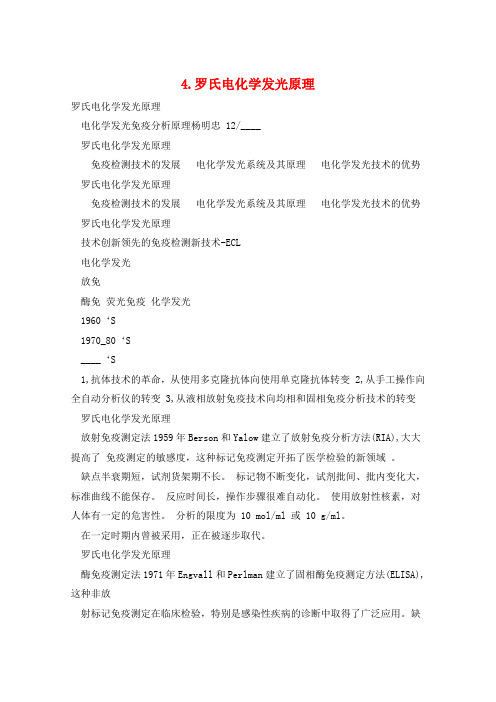
4.罗氏电化学发光原理罗氏电化学发光原理电化学发光免疫分析原理杨明忠 12/____罗氏电化学发光原理免疫检测技术的发展电化学发光系统及其原理电化学发光技术的优势罗氏电化学发光原理免疫检测技术的发展电化学发光系统及其原理电化学发光技术的优势罗氏电化学发光原理技术创新领先的免疫检测新技术-ECL电化学发光放免酶免荧光免疫化学发光1960‘S1970_80‘S____‘S1,抗体技术的革命,从使用多克隆抗体向使用单克隆抗体转变 2,从手工操作向全自动分析仪的转变 3,从液相放射免疫技术向均相和固相免疫分析技术的转变罗氏电化学发光原理放射免疫测定法1959年Berson和Yalow建立了放射免疫分析方法(RIA),大大提高了免疫测定的敏感度,这种标记免疫测定开拓了医学检验的新领域。
缺点半衰期短,试剂货架期不长。
标记物不断变化,试剂批间、批内变化大,标准曲线不能保存。
反应时间长,操作步骤很难自动化。
使用放射性核素,对人体有一定的危害性。
分析的限度为 10 mol/ml 或 10 g/ml。
在一定时期内曾被采用,正在被逐步取代。
罗氏电化学发光原理酶免疫测定法1971年Engvall和Perlman建立了固相酶免疫测定方法(ELISA),这种非放射标记免疫测定在临床检验,特别是感染性疾病的诊断中取得了广泛应用。
缺点试剂制备困难。
操作步骤复杂,耗时长。
影响因素多,质量控制难以保证。
最后测定的是颜色的光密度,其精密度和敏感性不如发光免疫技术。
各实验室操作不规范,质量难以保证。
有学者认为ELISA 技术已逐步走向退化,可能会逐步退出临床实验室。
罗氏电化学发光原理化学发光免疫测定法化学发光免疫测定法出现于20世纪90年代初。
由于最后测定的是光子的量,不但对检测者无害,其敏感度和精密度均优于RIA,而且试剂较稳定,并可进行全自动分析。
缺点采用标记催化酶(如辣根过氧化物酶)或化学发光分子(如鲁米诺)的方法,其化学反应一般不稳定,为间断的、闪烁性发光,而且在反应过程中易发生裂变,导致反应结果不稳定。
09- 罗氏电化学发光免疫分析仪测试项目质控物保存方法
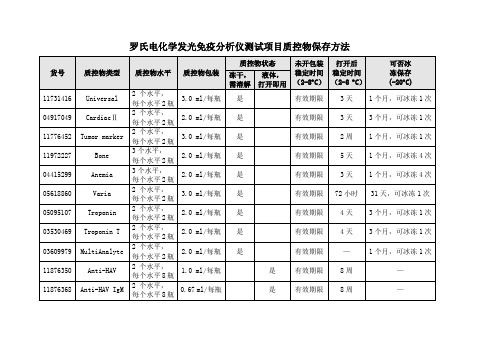
—
1个月,可冰冻1次
04899881
Maternal Care
3个水平,
每个水平2瓶
2.0 ml/每瓶
是
有效期限
—
3个月,可冰冻1次04Fra bibliotek55346ACTH
2个水平,
每个水平2瓶
2.0 ml/每瓶
是
有效期限
—
1个月,可冰冻1次
05109477
IL-6
2个水平,
每个水平2瓶
2.0 ml/每瓶
是
Anti-HAV IgM
2个水平,
每个水平8瓶
0.67 ml/每瓶
是
有效期限
8周
—
货号
质控物类型
质控物包装
质控物状态
未开包装
稳定时间
(2-8C)
打开后
稳定时间
(2-8C)
可否冰
冻保存
(-20C)
冻干,
需溶解
液体,
打开即用
11876325
Anti-HBc
2个水平,
每个水平8瓶
1.3ml/每瓶
是
有效期限
Troponin T
2个水平,
每个水平2瓶
2.0 ml/每瓶
是
有效期限
4天
3个月,可冰冻1次
03609979
MultiAnalyte
2个水平,
每个水平2瓶
2.0 ml/每瓶
是
有效期限
—
1个月,可冰冻1次
11876350
Anti-HAV
2个水平,
每个水平8瓶
1.0 ml/每瓶
是
有效期限
8周
罗氏电化学发光

80~120T/h 60~90T/h 一次60~90个,随时添加 30,66,75个不等 20个,随时添加 6,15个,不可添加 可随时添加 有条件限制
AxSYM与Elecsys主要性能比较
AxSYM
反应区 每个测试独立反应区
Elecsys
流动池结构
优势
试剂混匀方式 试剂稳定性 定标周期 标准品 质控 灵敏度(TSH) 精密度 携带率
自动转测 有 第一出结果时间 8分钟 吸样方式 探针 组合配套 有,随意无限 触摸屏 有 试剂盒自动开盖 有 试剂条码 标准曲线数 有,一维,可手工输入 4条不同批号曲线
雅培与罗氏肝炎试剂比较(1)
雅培 罗氏
种类
定量项目 检测步骤
甲,乙,丙肝炎
HAV-IgG,AUSAB,HBe 一步法(HAV,CORE),二步法 (HBsAg,AUSAB,HBe, Anti-HBe, HCV)三步法(HAV-IgM,CORE-M)
ECL检测技术原理
二价的三联吡啶钌在电场的作用下,失去一个电子氧
化成三价的三联吡啶钌
同时,在电场作用下,三丙胺也失去一个电子被氧化,
然后脱氢成三丙胺自由基
三丙胺自由基传递一个电子给三价的三联吡啶钌使
之进入激发态
激发态的三联吡啶钌不稳定,以发射一个波长为
620nm的光子的形式释放能量而回到基态三联吡啶 钌不被消耗,即发光标记物可循环发光
Elecsys 2010系统浏览
ห้องสมุดไป่ตู้试剂样品探针,使用一次性 Tip头,一个测试2~3只,仍 需蒸溜水请洗
混匀搅拌棒,蒸溜水清洗
Elecsys 2010系统浏览
•反应杯架:60X3(最多5架) •Tip头架:120X3(最多5架) •孵育架:32个位置(有限) •机械抓手,容易机械故障
罗氏ECL电化学免疫仪检测项目与参考范围
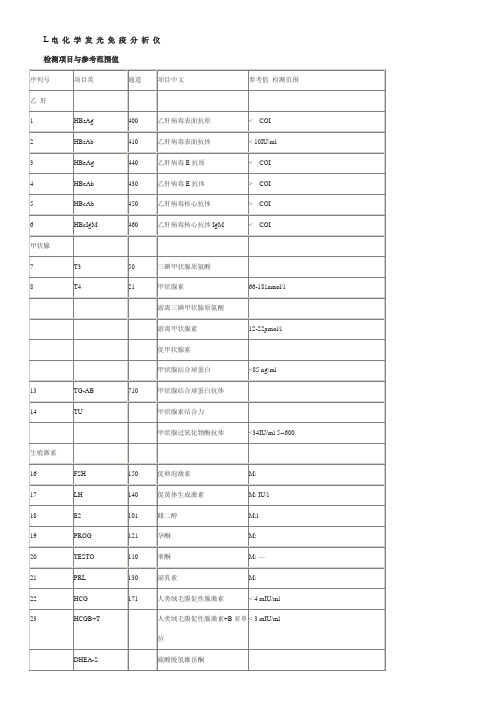
DHEA-S
硫酸脱氢雄甾酮
肿瘤
24
AFP
310
甲胎蛋白
≤ml
25
CEA
301
癌胚抗原
< ml
吸烟:< ml
26
FER
380
铁蛋白
M:30-400ng/ml
W13-150ng/ml 0500-2000
27
CA125
341
癌抗原125
< 35U/ml
28
CA15-3
332
癌抗原15-3
34
FPSA
391
游离前列腺特异性抗原
F:T>
贫血
35
FER
380
铁蛋白
M:30-400ng/ml
W13-150ng/ml 0500-2000
36
VitB12
600
维生素B12
197-866g/ml 145-637pmol/l
30-2000pg/ml22-1476pmol/l
37
FOL
610
叶酸
骨代谢
38
PTH
680
甲状旁腺素
15-65pg/ml
39
B-Crosslaps
670
B-胶原特殊序列
附pg/ml
40
N-MID
660
N-端骨钙素
附
糖尿病
41
INSULIN
650
胰岛素
药物
42
Cortisol
160
可的松
Am7-10:171-536nmol/ml
Pm 4-8: 64-340 nmol/ml
罗氏COBAS6000全自动电化学发光免疫分析仪性能验证
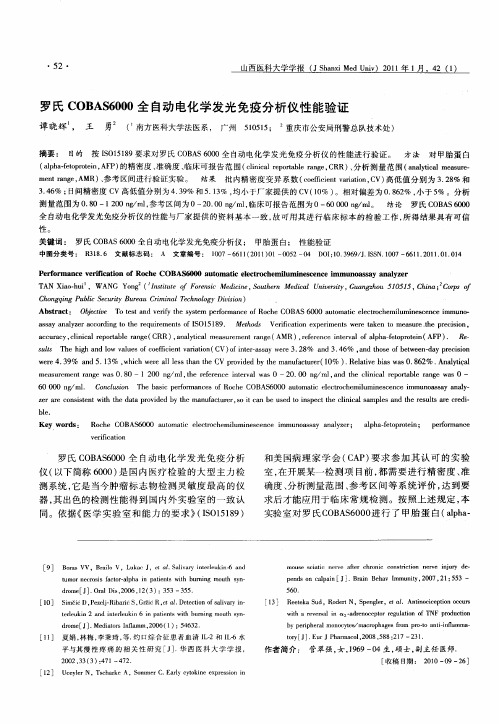
.
C og i ul eui u a r n l ehooyDv i ) hn qn P b ScryB r uCi a cnl i o g c i t e mi T g  ̄n
A s a t O j t e T s a dv rytess m p r r a c f o h O A 0 0a t ai e c o h m lmi se c u o b t c : bc v r e i ot t n e f h yt e om n eo R c eC B S6 0 uo t l t c e i n c n ei n - e i e f m c er u e mm
a c rc ,l i l e ot l rn e C R) a a t a m aue e t a g ( MR) r ee c t v l f lh — tpo i ( F ) R — cu ay c n a r r be a g ( R , n l i l es rm n rn e A ic p a yc ,e r ei e a o p af o rt n A P . e f n n r a e e
・
5 2・
酉医 大学学报 ( hni e nv 0 1 1 ,4 ( JS ax M dU i)2 1 年 月 2 1
罗 氏 C A 60 OB S0 0全 自动 电化 学发 光 免 疫 分 析仪 性 能 验 证
罗氏Cobase601电化学发光免疫分析仪的故障分析与维修

图1 试剂针及传动组件实物图
用于测定试剂针垂直方向是否停留在准确位置的传)试剂针传动组件出现故障。
传动组件由电机
图2 卡簧断裂的轴承
图3 完好的轴承
故障案例二
4.1 故障现象
仪器在使用过程中,操作软件出现一级报警
Tip/Cup Gripper Movement”,报警代码为
此报警内容为:抓手出现异常动作
对这项报警有更详细的描述“Tip Cup Gripper finger did 表示抓手未关闭。
故障分析
抓手开合动作的位置是否准确由传感器来检测
传感器表面被灰尘污染会导致抓手报警。
(
图4 抓手整体构造图
故障处理
对于第一种故障原因,应用洗耳球清洁传感器再从操作软件的“综合功能”的“维护”界面中执行抓手重复动作的命令。
(2)对于第二种故障原因,若发现抓手片表面附着血清,则应用棉签清除血清。
(3)在
面中执行抓手动作的命令,若抓手能启动,则基本可以排除。
笔者在本次的维修中,观察到抓手片表面附着大量固体
而且很难彻底清除,这就是出现本次故障的直接原因经过本次维修,笔者将清洁抓手片的项目添加到这台机器的,以定期维护,大大降低抓手的故障率
Cobas e601电化学发光免疫分析仪有强大的故障
,仪器通过自身的传感器,在其运转过程中实时或在固定时间段进行测量,获取压力、位置等信息
件中对故障有详细的描述,同时会对故障进行初步判断并给,维修人员可以将软件中故障解决方案和维修经验相结合的方式对仪器进行故障分析与维修。
罗氏电化学发光免疫分析仪项目推荐稀释比例

hGH
1110/01
N-MID Osteocalcin
0308/11
PTH + STAT
0210/19
PTH (1-84)
0511/01
total P1NP
0508/06
Vitamin Dtotal
0211/01
Brahms PCT
0210/04
IL-6
0710/03
Anti-CCP
0210/03
1:5 with Diluent MA
> 1835 pmol/l
> 500 pg/ml
FSH
HCG+
HCG(STAT)
1:100 with Diluent Universal*
> 100 mIU/ml
LH
Progesterone II
1:10 with Diluent Estradiol / Progesterone*
> 1 µg/l
Down`s
syndrome screening
Free ßhCG
1:10with Diluent Universal
> 19 IU/l
PAPP-A
1:10with Diluent Universal
> 500 mIU/l
Anaemia
Vitamin B12
1:2with Diluent Universal
> 4 IU/l
Cardiac
CK-MB(STAT)
1:2 with DiluentMA
> 50 ng/ml
Digoxin
1:2 with Diluent Universal
罗氏电化学发光免疫分析仪测试项目质控物保存方法

3个水平,
每个水平2瓶
2.0 ml/每瓶
是
有效期限
3天
1个月,可冰冻4次
05618860
Varia
2个水平,
每个水平2瓶
3。0 ml/每瓶
是
有效期限
72小时
31天,可冰冻1次
05095107
Troponin
2个水平,
每个水平2瓶
2。0 ml/每瓶
是
有效期限
4天
3个月,可冰冻1次
03530469
04899881
Maternal Care
3个水平,
每个水平2瓶
2。0 ml/每瓶
是
有效期限
—
3个月,可冰冻1次
04655346
ACTH
2个水平,
每个水平2瓶
2.0 ml/每瓶
是
有效期限
—
1个月,可冰冻1次
05109477
IL—6
2个水平,
每个水平2瓶
2。0 ml/每瓶
是
有效期限
5小时
3个月,可冰冻1次
TroponinT
2个水平,
每个水平2瓶
2.0 ml/每瓶
是
有效期限
4天
3个月,可冰冻1次
03609979
MultiAnalyte
2个水平,
每个水平2瓶
2.0 ml/每瓶
是
有效期限
—
1个月,可冰冻1次
11876350
Anti—HAV
2个水平,
每个水平8瓶
1。0 ml/每瓶
是
有效期限
8周
—
11876368
Anti—HAV IgM
4.罗氏电化学发光原理

保证最终检测结果的高灵敏度;
利用磁性分离技术,实现全自动化分析。 与其它几种标记免疫测定技术相比,电化学发光具有更多的优点: 1. 2. 3. 4. 5. 6. 高灵敏度,检测下限达pmol; 线形范围宽,达7个数量级; 快速,出第一个结果的时间仅需数分钟; 应用范围广,可以同样的灵敏度和线性范围检测各种物质,包括DNA; 试剂稳定,无污染和衰变问题; 自动化程度高。
电化学发光免疫分析原理
杨明忠 12/2014
• 免疫检测技术的发展 • 电化学发光系统及其原理 • 电化学发光技术的优势
• 免疫检测技术的发展 • 电化学发光系统及其原理 • 电化学发光技术的优势
技术创新领先的免疫检测新技术-ECL
电化学发光
放免
酶免 荧光免疫 化学发光
1960‘S
1970~80‘S
化学发光免疫测定法
化学发光免疫测定法出现于20世纪90年代初。由于最后测定的是光子的量, 不但对检测者无害,其敏感度和精密度均优于RIA,而且试剂较稳定,并可 进行全自动分析。 缺点 采用标记催化酶(如辣根过氧化物酶)或化学发光分子(如鲁米诺)的方 法,其化学反应一般不稳定,为间断的、闪烁性发光,而且在反应过程中 易发生裂变,导致反应结果不稳定。 检测时需对结合相与游离相进行分离,操作步骤多。 反应原理相对落后。
在电极阳极表面,以上两种电化学活性物质同时失去电子发生氧 化反应,2价的[Ru(bpy)2+3] 标记物被氧化成3价的[Ru(bpy)3+3] 的标 记物,TPA被氧化成阳离子自由基TPA+* , TPA+* 很不稳定,自发地失 去一个质子而形成自由基TPA* ,其为强还原剂,将一个电子给3价的 [Ru(bpy)3+3] ,使其成为激发态的Ru(bpy)2+3 ,而TPA自身被氧化成氧 化产物。激发态的Ru(bpy)2+3衰减时发射一个波长620nm的光子,重新 形成基态的Ru(bpy)2+3 。这一过程在电极表面周而复始进行,产生许 多光子。使得光信号增强。
罗氏电化学发光化学发光检测结果

罗氏电化学发光化学发光检测结果罗氏电化学发光化学发光检测(Roche electrochemiluminescence immunoassay,ECLIA)是一种基于化学发光原理的生化检测技术,广泛应用于临床诊断、药物筛选、环境监测等领域。
该技术具有灵敏度高、特异性好、操作简便、结果稳定等优点,因此受到了广泛关注和应用。
本文将从技术原理、应用范围和发展趋势等方面对罗氏电化学发光化学发光检测进行详细介绍。
一、技术原理罗氏电化学发光化学发光检测技术是基于电化学发光和化学发光原理的一种生化检测技术。
其基本原理是通过特定的抗体-抗原反应,将感兴趣的生物分子标记上特定的发光分子,当这些标记分子与特定底物反应时,产生化学反应产生发光。
通过检测产生的化学发光信号大小来定量分析待测物质的浓度。
罗氏电化学发光化学发光检测技术主要包括三个关键步骤:标记、洗脱和检测。
首先,将待检测物质与特定的抗体结合,并标记上发光物质。
然后,利用特定的洗脱方法将未反应的物质除去,最后通过检测设备对发光的强度进行测定。
二、应用范围罗氏电化学发光化学发光检测技术在临床诊断、药物筛选、环境监测等领域有着广泛的应用。
在临床诊断领域,该技术被应用于各种疾病的早期筛查、疾病的诊断与分型、治疗效果的监测等方面。
例如,在肿瘤标志物、感染性疾病、免疫相关疾病等方面都有广泛的应用。
在药物筛选方面,罗氏电化学发光化学发光检测技术可以用于快速检测潜在药物的毒性、药效、药代动力学等参数,帮助研究人员更快速地筛选出有效的药物。
在环境监测方面,该技术可以用于水质、空气、土壤等环境样品中有毒有害物质的检测,为环境保护提供有力的技术支持。
三、发展趋势随着生物技术的不断发展和进步,罗氏电化学发光化学发光检测技术也在不断创新和发展。
未来,该技术将有以下几个发展趋势:1.高通量化:随着自动化技术的发展,罗氏电化学发光化学发光检测技术将更加高效、快速,实现高通量的检测。
2.多参数检测:未来的罗氏电化学发光化学发光检测技术将可以同时检测多种生物标志物,实现多参数的综合分析。
罗氏电化学发光原理
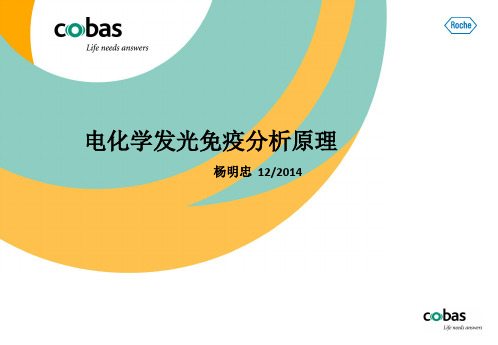
双抗夹心法 & 桥联免疫法
Sandwich Principle
双抗夹心法
large molecular weight antigens are measured
directly proportional measurement, means: low signal = low concentration high signal = high concentration e.g. TSH, CA 15-3 II – assays
e.g. T4, Folate II – assays
电化学发光免疫系统核心原理
✓电化学发光 ✓磁性微粒子固相 ✓亲和素- 生物素间接包被 ✓流动池检测系统 ✓简单试剂管理,先进的定标概念
磁性微粒子固相载体的优点
•直径最小– 2.8um •表面积大而均一 •磁性微粒子呈悬浮状态 •使异相反应变成类均相反应 •加快反应速度 •提高反应灵敏度
A N T IG E N
B IO T IN Y L A T E D A N T IG E N
R U T H E N IU M L A B E L L E D A N T IB O D Y
S T R E P T A V ID IN -C O A T E D M IC R O P A R T IC L E
电化学发光免疫分析原理
杨明忠 12/2014
• 免疫检测技术的发展 • 电化学发光系统及其原理 • 电化学发光技术的优势
• 免疫检测技术的发展 • 电化学发光系统及其原理 • 电化学发光技术的优势
技术创新领先的免疫检测新技术-ECL
电化学发光
放免
酶免 荧光免疫 化学发光
1960‘S 1970~80‘S
罗氏COBAS6000全自动电化学发光免疫分析仪性能验证
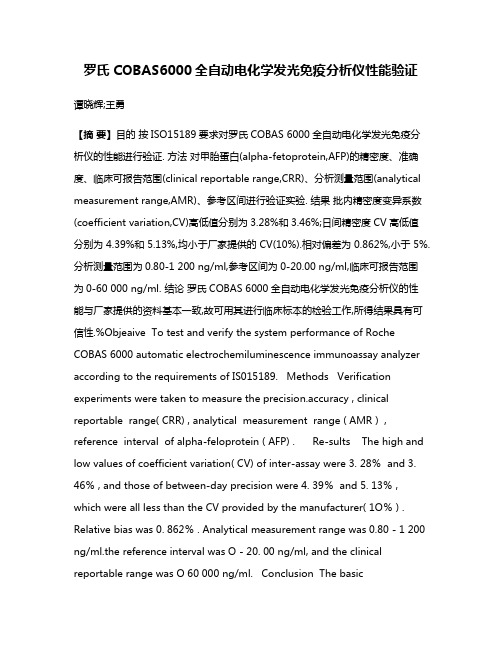
罗氏COBAS6000全自动电化学发光免疫分析仪性能验证谭晓辉;王勇【摘要】目的按ISO15189要求对罗氏COBAS 6000全自动电化学发光免疫分析仪的性能进行验证. 方法对甲胎蛋白(alpha-fetoprotein,AFP)的精密度、准确度、临床可报告范围(clinical reportable range,CRR)、分析测量范围(analytical measurement range,AMR)、参考区间进行验证实验. 结果批内精密度变异系数(coefficient variation,CV)高低值分别为3.28%和3.46%;日间精密度CV高低值分别为4.39%和5.13%,均小于厂家提供的CV(10%).相对偏差为0.862%,小于5%.分析测量范围为0.80-1 200 ng/ml,参考区间为0-20.00 ng/ml,临床可报告范围为0-60 000 ng/ml. 结论罗氏COBAS 6000全自动电化学发光免疫分析仪的性能与厂家提供的资料基本一致,故可用其进行临床标本的检验工作,所得结果具有可信性.%Objeaive To test and verify the system performance of Roche COBAS 6000 automatic electrochemiluminescence immunoassay analyzer according to the requirements of IS015189. Methods Verification experiments were taken to measure the precision.accuracy , clinical reportable range( CRR) , analytical measurement range ( AMR ) , reference interval of alpha-feloprotein ( AFP) . Re-sults The high and low values of coefficient variation( CV) of inter-assay were 3. 28% and 3. 46% , and those of between-day precision were 4. 39% and 5. 13% , which were all less than the CV provided by the manufacturer( 1O% ) . Relative bias was 0. 862% . Analytical measurement range was 0.80 - 1 200 ng/ml.the reference interval was O - 20. 00 ng/ml, and the clinical reportable range was O 60 000 ng/ml. Conclusion The basicperformances of Roche COBAS6000 automatic electrochemiluminescence immunoassay analyzer are consistent wich the data provided by the manufacturer,so it can be used to inspect the clinical samples and the results are credible.【期刊名称】《山西医科大学学报》【年(卷),期】2011(042)001【总页数】4页(P52-55)【关键词】罗氏COBAS 6000全自动电化学发光免疫分析仪;甲胎蛋白;性能验证【作者】谭晓辉;王勇【作者单位】南方医科大学法医系,广州,510515;重庆市公安局刑警总队技术处【正文语种】中文【中图分类】R318.6罗氏COBAS6000全自动电化学发光免疫分析仪(以下简称6000)是国内医疗检验的大型主力检测系统,它是当今肿瘤标志物检测灵敏度最高的仪器,其出色的检测性能得到国内外实验室的一致认同。
罗氏cobas-e411型全自动电化学发光免疫分析仪常见故障维修分析三例

设备维修DEVICE MAINTENANCE引言Cobas-E411型电化学发光免疫分析仪由分析仪和控制装置组成。
该仪器采用最先进的电化学发光技术,对体外多种物质进行定量测定,具有全自动、随机存取、条形码识别、软件智能控制系统,有较高的灵敏度和较宽的检测范围,应用专利的包被技术、独特的载体、稳定的发光配套试剂[1]。
检测速度为86个测试/h,可同时检测18个项目。
仪器在运行过程中,若出现报警信息,屏幕上方状态栏的颜色会发生改变并有报警声音提示。
因采用原装进口配套试剂,测定成本较高,而当仪器出现机械故障时所有检测操作会立刻被停止,还未测试出结果的项目因此被废止。
为充分有效利用资源,避免仪器故障发生,减少损失,保证仪器正常运行,工作人员需要认真总结仪器维修和保养经验,及时排除故障[2]。
1 罗氏Cobas-E411型电化学发光免疫分析仪基本工作原理电化学发光免疫分析是基于对抗原和抗体的特异性反应进行的检测[3],通过抗原、抗体反应和磁珠分离技术的特点,增强放大效应显示物质的性质与含量。
其原理是:仪器通过机械抓手把分析吸头、反应杯抓取至检测池孵育孔内;分析吸头通过S/R针,吸取样品和试剂并加入反应杯中进行孵育,孵育在37℃±0.3℃下进行,在底物三联吡啶钌[Ru(bpy)2+3]N羟基琥珀酰胺酯和三丙胺(Tripropyl Amine,TPA)作用下,电极阳极表面发生电化学发光反应,两种电化学活性物质同时失去电子发生氧化反应,2价的[Ru(bpy)2+3]标记物被氧化成3价的[Ru(bpy)3+3]的标记物,TPA被氧化成阳离子自由基TPA+*,TPA+*不稳定,自发地失去一个质子而形成自由基TPA*,其为强还原剂,将一个电子给3价的[Ru(bpy)3+3],使其成为激发态的Ru(bpy)2+3,而TPA自身被氧化成氧化产物。
激发态罗氏Cobas-E411型全自动电化学发光免疫分析仪常见故障维修分析三例李迎军,李滢超,马各富昆明医科大学第二附属医院石林天奇医院检验科,云南石林 652200[摘 要] 罗氏Cobas-E411型电化学发光免疫分析仪由于高频率的使用,导致了较高的故障发生率。
- 1、下载文档前请自行甄别文档内容的完整性,平台不提供额外的编辑、内容补充、找答案等附加服务。
- 2、"仅部分预览"的文档,不可在线预览部分如存在完整性等问题,可反馈申请退款(可完整预览的文档不适用该条件!)。
- 3、如文档侵犯您的权益,请联系客服反馈,我们会尽快为您处理(人工客服工作时间:9:00-18:30)。
罗氏电化学发光免疫分
析
标准化管理处编码[BBX968T-XBB8968-NNJ668-MM9N]
罗氏电化学发光免疫分析
技术是罗氏公司开发的,但全自动机械制造却由日本的日立公司承担,
所以仪器上还有Hitachi的标志。这个仪器让大家吃惊的一大原因就在于一
直在实验室研究的电致化学发光居然已经真正地产业化了,其中我们一直无
法解决的诸多问题(尤其是重现性)均已得到解答,看来罗氏的确花了不少
心血开发这款仪器。
罗氏电化学发光免疫分析技术的性能特点——创新的技术,与众不同
一、最先进的检测原理
电化学发光免疫测定,是目前最先进的标记免疫测定技术,是继放射免疫、
酶免疫、荧光免疫、化学发光免疫测定以后的新一代标记免疫测定技术,具有
敏感、快速和稳定的特点,在固相标记免疫测定中技术上居领先地位。
电化学发光(ECL)是一种在电极表面由电化学引发的特异性化学发光反应,
实际上是电化学和化学发光两个过程的完美结合。电化学发光与普通化学发光
的主要差异在于前者是电启动发光反应,循环及多次发光,后者是通过化合物
混合启动发光反应,是单次瞬间发光。因此ECL反应易精确控制,重复性极
好。
电化学发光免疫测定是电化学发光(ECL)和免疫测定相结合的产物,直
接以[Ru(bpy)3]2+标记抗体,反应时标记物直接发光。且[Ru(bpy)3]2+在电
极表面的反应过程可以周而复始进行,产生许多光子,使光信号得以增强。
二、专利的包被技术
链霉亲和素(streptoavidin,SA)和生物素(biotin,B)是具有很强的非
共价相互作用的一对化合物,特异性强且结合紧密。一分子SA可与四分子B
相结合,增大了抗体结合量,达到放大效果。在ECL的试剂中,SA通过特殊的
蛋白结合物均匀牢固地包被在磁性微粒上,形成通用的能与B结合的固相载
体,另一试剂为活化的B衍生物化合的抗原或抗体。两种试剂混合时,抗原或
抗体即包被在磁性微粒上。
三、独特的载体
ECL中采用的固相载体是带有磁性的直径约m的聚苯乙烯微粒。其特点是反应
面积极大,比板式扩大20-30倍,使反应在近乎液相中进行,反应速度大大
加快,利用氧化铁的磁性,使用电磁场分离结合态和游离态,方便迅速,实现
了精确的全自动化。
四、独到的磁分离技术
实现了结合相和游离相的完全自动化分离,且检测池在无电场时彻底清洗,
避免了交叉污染。
五、超高的测定灵敏度和测定线性
发光信号检测的宽线性加上电化学发光独特的标记物本身(发光底物)循环
发光和专利的链霉亲和素-生物素包被技术的信号放大作用,使电化学发光测
定的检测下限可达10-12和10-18级,线性范围最大超越7个数量级,在待测抗原
(抗体)极微量或达到病理期极限时,均能准确测定,避免了样本稀释重测
定,既节约时间,又节省试剂。
六、稳定的试剂
电化学发光标记物三联吡啶钌在无电场和递电子体(三丙胺)存在的自然环
境下非常稳定,保证了用它标记的抗体(抗原)试剂也非常稳定,2-8℃可稳
定一年以上,批内和批间变异系数分别为<4%和<7%,在首日使用之后也可以稳
定3个月。
七、简便创新的定标概念
每个测定项目的基本定标曲线已由罗氏公司完成,并已存入试剂的二维条形
码,自动读入仪器,用户只需进行二点重定标即可。
八、简便稳妥的二维条形码——当代最先进的全自动信息处理技术
二维条形码是电化学发光分析仪的“信息高速公路”,可以存储超过一千字
节的信息,使同批试剂仅做一次2点定标,亦使仪器自动化程度升高,不必做
大量的定标、质控等前期工作,厂家已做12点标准曲线,既节约时间,又保
障结果的准确。
九、先进的闪烁存储技术
断电时软件数据永不丢失,避免硬盘损坏,导致系统崩溃,启动速度比硬盘
快10倍。
十、广泛的应用范围和广阔的开发前景
检测项目广泛应用于甲状腺、性激素、骨代谢、心肌梗塞、肿瘤标志物、传
染病抗原抗体等的定量测定。
ECL分析原理中采用三联吡啶钌作为标记物,其活化衍生物是三联吡啶钌+N
羟基琥珀酸胺酯(NHS)。该衍生物性能稳定,且分子量很小,产生的空间位
阻小,与免疫球蛋白的分子比超过20仍不会影响抗体的可溶性和免疫活性,
因此它可与抗体、半抗原、激素、核酸等各种生物分子结合形成稳定的标记
物,使检测的菜单大大丰富,为其检测菜单的开发前景提供了广阔空间。
罗氏收购宝灵曼后,设有专职的研发部门为电化学发光分析仪开发配套试剂,
所以每年都会有5-10个新项目问世,为用户的项目拓展奠定了基础。
